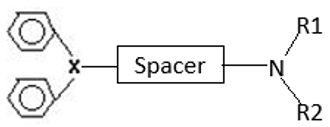This set of Drug Biotechnology Quiz focuses on “Drug Concentration and Pharmacologic Response – Antihistamines – 2”.
1. Which class of drugs has these common structural features?

a) 1st generation antihistamines
b) 2nd generation antihistamines
c) 3rd generation antihistamines
d) 4th generation antihistamines
View Answer
Explanation: 1st generation antihistamines has 2 aromatic rings, connected to a central carbon, nitrogen, or oxygen. Spacer between central atom and the amine, usually 2-3 carbons in length. (Can be linear, ring, branched, saturated or unsaturated). The amine is substituted with small alkyl groups. Chirality at X and having the rings in different planes increases potency of the drug.
2. What are the characteristics of 2nd generation h1 receptor antagonists?
a) Selective for peripheral H1 receptors
b) Opposed to CNS H1 receptors
c) Selective for peripheral H1 receptors and opposed to CNS receptors
d) Selective to H1 receptors of CNS
View Answer
Explanation: These are the newer drugs and they are much more selective for the peripheral H1-receptors involved in allergies as opposed to the H1-receptors in the CNS. Therefore, these drugs provide the same relief with many fewer adverse side effects.
3. Which of the following drug are over the counter drug?
a) Loratidine
b) Terfenadine
c) Desloratidine
d) Fexofenadine
View Answer
Explanation: Loratidine is the only drug of its class available over the counter. It has long lasting effects and does not cause drowsiness because it does not cross the BBB. Terfenadine was formerly used to treat allergic conditions. In the 1990’s it was removed from the market due to the increased risk of cardiac arrhythmias.
4. Which of the following drug is of Ethylenediamine class?
a) Mepyramine
b) Diphenhydramine
c) Cyclizine
d) Chlorphenamine
View Answer
Explanation: Ethylenediamine were the first group of clinically effective H1-antihistamines. Ethylenediamine constitute of mepyramine. Diphenhydramine is of ethanolamine class. Chlorphenamine is of alkylamine class. Cyclizine is of piperazines class, structurally related to the ethylenediamines and the ethanolamines.
5. Which of the following drug is of Ethanolamine class?
a) Mepyramine
b) Diphenhydramine
c) Cyclizine
d) Chlorphenamine
View Answer
Explanation: Ethylenediamine consists of mepyramine. Diphenhydramine is of ethanolamine has significant anticholinergic side effects and sedation. Chlorphenamine is of alkylamine class. Cyclizine is of piperazines class, structurally related to the ethylenediamines and the ethanolamines used most often to treat motion sickness, vertigo, nausea, and vomiting.
6. Which of the following drug is of Alkylamine class?
a) Mepyramine
b) Diphenhydramine
c) Cyclizine
d) Chlorphenamine
View Answer
Explanation: Ethylenediamine were the first group of clinically effective H1-antihistamines for example mepyramine. Diphenhydramine is of ethanolamine class. Chlorphenamine is of alkylamine class these drugs have fewer sedative and GI adverse effects, but a greater incidence of CNS stimulation. Cyclizine is of piperazines class.
7. Which of the following drug is of Piperazine class?
a) Mepyramine
b) Diphenhydramine
c) Cyclizine
d) Chlorphenamine
View Answer
Explanation: Ethylenediamine has mepyramine in its class. Diphenhydramine is of ethanolamine class. Chlorphenamine is of alkylamine class. Cyclizine is of piperazines class, structurally related to the ethylenediamines and the ethanolamines and thus produces significant anticholinergic effects. Used most often to treat motion sickness, vertigo, nausea, and vomiting.
8. Synthesis of histamine needs the enzyme histidine decarboxylase.
a) True
b) False
View Answer
Explanation: Histamine, when released, causes inflammation by increasing vasodilation, capillary permeability, causing smooth muscle contraction, mucus secretion, and parasympathetic nerve stimulation. Formed from the amino acid Histidine in a decarboxylation reaction with the enzyme histidine decarboxylase. Occurs primarily in mast cells and basophils.
9. Antihistamines are only for H2 receptor antagonists.
a) True
b) False
View Answer
Explanation: A drug that reduces or eliminates the effects mediated by the chemical histamine. True antihistamines are only the agents that produce a therapeutic effect that is mediated by negative modulation of histamine receptors. The term antihistamine only refers to H1 receptor antagonists. Antihistamines compete with histamine for binding sites at the receptors. Antihistamine cannot remove the histamine if it is already bound.
Sanfoundry Global Education & Learning Series – Drug and Pharmaceutical Biotechnology.
To practice all areas of Drug Biotechnology for Quizzes, here is complete set of 1000+ Multiple Choice Questions and Answers.
If you find a mistake in question / option / answer, kindly take a screenshot and email to [email protected]
- Check Drug and Pharmaceutical Biotechnology Books
- Practice Biotechnology MCQs
- Check Biotechnology Books
- Apply for Biotechnology Internship
